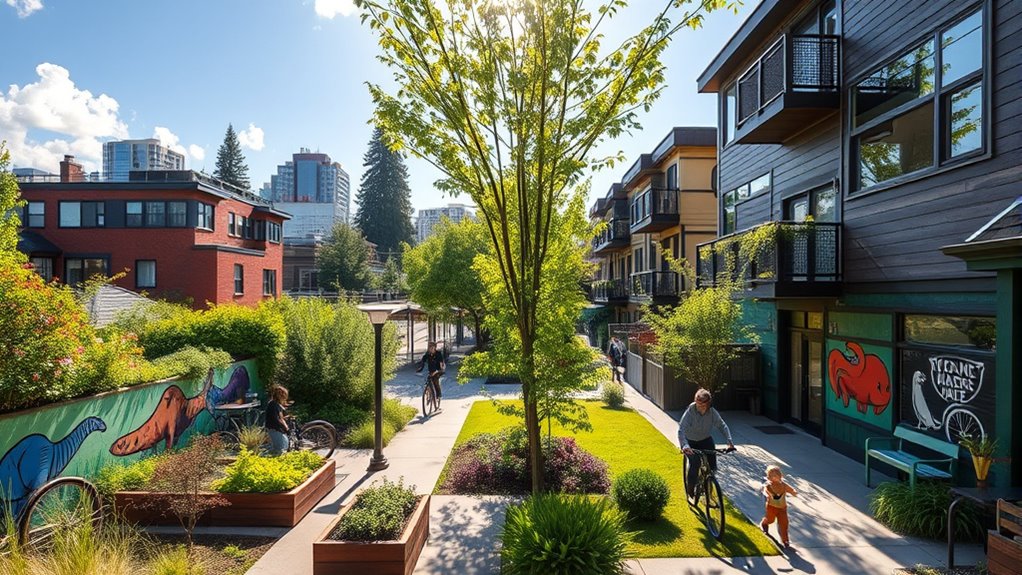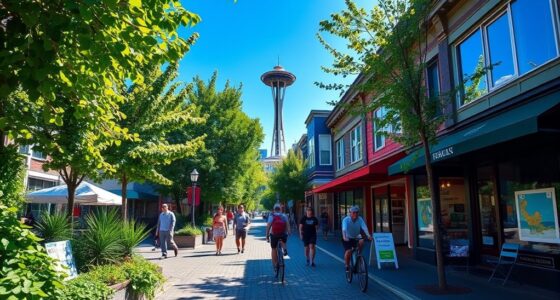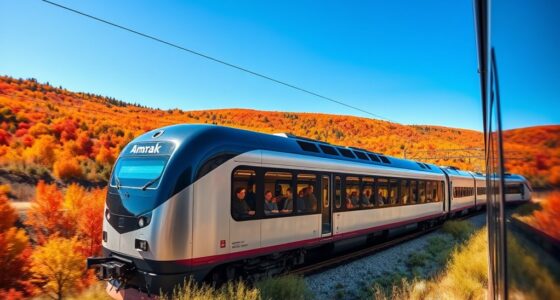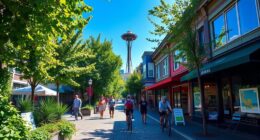If you’re looking to explore sustainable neighborhoods in Seattle, check out Beacon Hill and South Seattle. These areas boast urban agriculture like rooftop gardens and community farms, providing fresh produce and fostering local connections. You’ll find farmers’ markets and community gardens where you can get involved and learn about eco-friendly practices. Plus, you can see solar panels and wind turbines in action, showcasing the city’s commitment to renewable energy. There’s so much more to discover about these vibrant communities.
Key Takeaways
- Explore Beacon Hill for its vibrant community farms and rooftop gardens that promote urban agriculture and fresh produce access.
- Visit South Seattle to experience hands-on activities in community gardens that engage residents in sustainable practices.
- Check out local farmers’ markets across neighborhoods for fresh, locally sourced food and to foster community connections.
- Discover solar panels and wind turbines integrated into urban settings, showcasing Seattle’s commitment to renewable energy initiatives.
- Experience the blend of innovation and tradition in neighborhoods that prioritize eco-conscious living and sustainability practices.
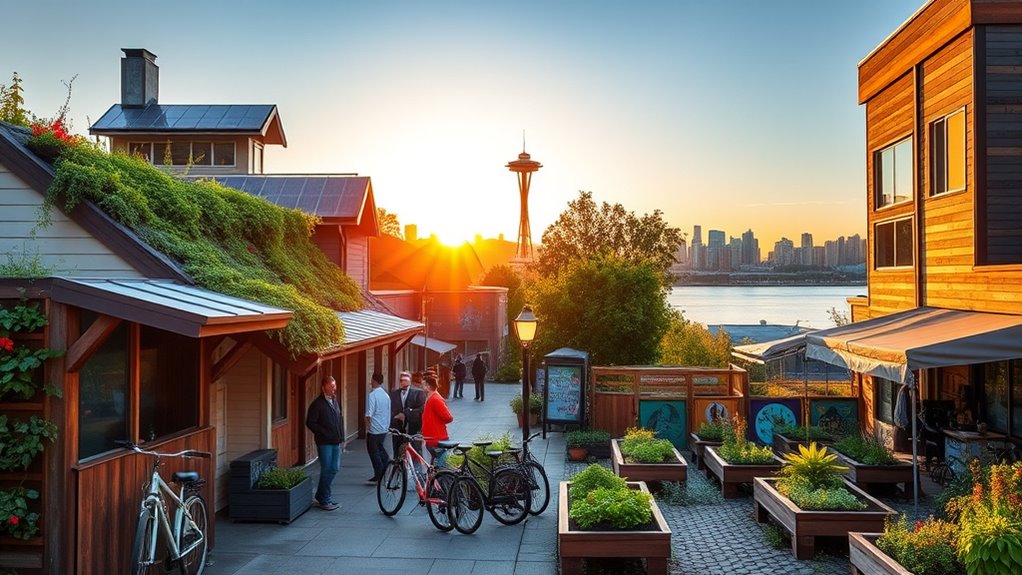
As you explore Seattle, you’ll find that sustainable neighborhoods are not just a trend but a way of life. This vibrant city is leading the charge in creating eco-friendly spaces that emphasize community, innovative practices, and a commitment to preserving the environment. One of the most exciting aspects of these neighborhoods is their focus on urban agriculture. You’ll discover rooftop gardens, community farms, and edible landscapes tucked away among the bustling streets. These green spaces not only provide fresh produce for residents but also foster a sense of community, encouraging neighbors to come together, share resources, and learn from each other.
In neighborhoods like Beacon Hill and South Seattle, you’ll see urban agriculture flourishing. Farmers’ markets are abundant, and local residents often participate in growing their own vegetables and herbs. You might even stumble upon a community garden where you can volunteer or take home a share of the harvest. This hands-on approach not only promotes sustainable living but also reconnects you with the food you consume. Engaging with urban agriculture allows you to appreciate the importance of sustainable practices and the impact they have on the environment.
Renewable energy is another key aspect of Seattle’s sustainable neighborhoods. As you wander through these areas, you’ll notice solar panels on rooftops and wind turbines strategically placed to harness natural resources. The city has made significant investments in renewable energy sources, aiming to reduce its carbon footprint and reliance on fossil fuels. You might even find community initiatives that encourage residents to switch to green energy providers or participate in energy efficiency programs. By embracing renewable energy, Seattle is setting a precedent for other cities to follow, showcasing how urban spaces can thrive while also being environmentally responsible.
As you soak in the vibrant atmosphere of Seattle’s sustainable neighborhoods, you’ll appreciate the blend of innovation and tradition. You’ll come to understand that these areas don’t just focus on sustainability for the sake of it; they embody a lifestyle that values eco-conscious living. Seattle’s commitment to urban agriculture and renewable energy creates a unique environment where you can learn, grow, and thrive alongside others who share your passion for sustainability. By exploring these neighborhoods, you’re not just witnessing a trend—you’re witnessing a movement that could inspire change in cities around the world.
Frequently Asked Questions
What Are the Benefits of Living in a Sustainable Neighborhood?
Living in a sustainable neighborhood offers you numerous benefits. You’ll enjoy cleaner air and reduced pollution, thanks to renewable energy sources powering your community. Urban gardening opportunities give you access to fresh produce, promoting healthier eating habits. You’ll also find a stronger sense of community, as neighbors often collaborate on sustainability initiatives. Plus, lower utility bills and increased property values are bonuses that come with investing in a greener lifestyle.
How Can I Contribute to Sustainability in My Neighborhood?
You can contribute to sustainability in your neighborhood by starting community composting initiatives and getting involved in urban gardening projects. Organize composting workshops to educate your neighbors on reducing waste, and create a shared garden space where everyone can grow fresh produce. By collaborating with others, you’ll strengthen community ties while promoting eco-friendly practices. Plus, you’ll enjoy the benefits of fresh vegetables and a cleaner environment together!
Are There Any Local Events Focused on Sustainability?
Yes, you can find local events focused on sustainability in your area. Check out community gardens hosting workshops on growing your own food or learn about renewable energy at local fairs. Many neighborhoods organize cleanup days and educational talks that cover various sustainability topics. You’ll not only gain valuable knowledge but also meet like-minded individuals who share your passion for creating a greener future. Keep an eye on community boards and social media for upcoming events!
What Transportation Options Are Available in These Neighborhoods?
In these neighborhoods, you’ve got plenty of transportation options. You can easily hop on public transit, like buses or light rail, which connect you to various parts of the city. If you prefer cycling, you’ll love the extensive bike lanes that make riding safe and enjoyable. Plus, many areas are walkable, so you can explore on foot. With these options, you can choose what suits your lifestyle best while reducing your carbon footprint.
How Do Sustainable Neighborhoods Impact Property Values?
Sustainable neighborhoods can positively impact property values. When you invest in areas with urban green spaces, you’ll likely see increased demand, as people are drawn to the aesthetics and health benefits. Additionally, renewable energy incentives attract eco-conscious buyers, further boosting value. Properties in these neighborhoods often appreciate faster than traditional ones, making them a smart investment for you. So, consider these factors when evaluating your next property purchase!
Conclusion
As you wander through Seattle’s vibrant sustainable neighborhoods, you’re not just exploring; you’re stepping into a modern-day Garden of Eden. Each community, from Ballard to Capitol Hill, showcases innovative practices that nurture both people and the planet. So, embrace your inner eco-warrior and discover the green gems waiting for you. Remember, every small step you take contributes to a brighter, more sustainable future for our beloved city. Your adventure in sustainability starts now!

